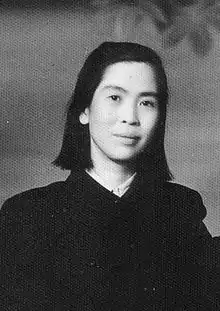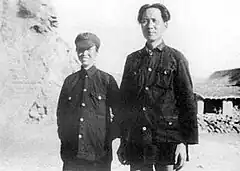He Zizhen | |||||||||
|---|---|---|---|---|---|---|---|---|---|
| 贺子珍 | |||||||||
 He Zizhen, 1947 | |||||||||
| Born | 20 September 1910 Yunshan, Jiangxi, Qing Dynasty | ||||||||
| Died | 19 April 1984 (aged 73) Shanghai, People's Republic of China | ||||||||
| Other names | Ven Iun, He Guiyuan | ||||||||
| Political party | Chinese Communist Party | ||||||||
| Spouse | |||||||||
| Children | Yang Yuehua, Li Min and 4 more | ||||||||
| Chinese name | |||||||||
| Traditional Chinese | 賀子珍 | ||||||||
| Simplified Chinese | 贺子珍 | ||||||||
| |||||||||
He Zizhen (Chinese: 贺子珍; pinyin: Hè Zizhēn; Wade–Giles: Ho Tzu-chen; 20 September 1910 – 19 April 1984) was the third wife of Chairman Mao Zedong from 1928 to 1937. She was one of the few female soldiers in the First Front Red Army that went on the Long March.
Early life and career

He Zizhen was born in Yunshan (云山, now Yongxin County), Jiangxi, in 1910, as He Guiyuan (贺桂圆), the second of four children.[1] He's family were impoverished scholar-gentry that ran a tea house and sent He to a free Protestant missionary school in her youth.[2] She joined the Communist Youth League of China in 1925 along with her siblings.[3] He Zizhen later graduated from the Yongxin Girls' School and became a full member of the Chinese Communist Party in 1926.
Revolutionary life
Early Communist Activities
As a party member He Zizhen was made head of the county's Women's Bureau and worked as a traveling propagandist. She fought in the Yongxin uprising of 1927 and began serve as a communist partisan.[1] An expert in guerrilla warfare and a capable fighter, He Zizhen was also an excellent shooter who earned the nickname of "Two-Gunned Girl General".[4]
Relationship with Mao and the Long March
He Zizhen was introduced to Mao Zedong at Jinggangshan by Yuan Wencai, a classmate of her elder brother, in the spring of 1928. She and Mao married in 1928.[5][6][7] When they married, Mao had not divorced his second wife Yang Kaihui, whom he had wed in 1920.[8][9] Yang was arrested and executed in 1930 by the Kuomintang.[10] While with Mao, He Zizhen restricted herself to clerical work and served as Mao's secretary.[1] Despite this, she was still severely injured by shrapnel in 1935 and needed to be carried by stretcher on parts of the Long March.[1] He Zizhen was one of around only 35 women on the Long March, and was pregnant for most of the march.
He Zizhen had three daughters and three sons with Mao Zedong, but except for their daughter, Li Min, all of them either died young or were separated from the family. This was partially due to the constant movement of the communists as they worked to evade the Kuomintang. Their eldest daughter, who was left to a local family in Fujian, was found and recognized by He Zizhen's brother in 1973, but never had the chance to meet Mao or He.[11] Two English researchers who retraced the entire Long March in 2002–2003 located a woman whom they believe might be a missing child left in the care of others by Mao and He in 1935.[12][13][14]
Divorce from Mao and sojourn in Russia
In 1937, Mao had allegedly begun an affair with Wu Lili, the interpreter of journalist Agnes Smedley.[1] After a confrontation with Mao, He Zizhen traveled to the Soviet Union for treatment of a wound suffered earlier in battle,[15] later attending the Communist Eastern University, under the pseudonym Ven Iun.[16] In Moscow, in 1938, He Zizhen gave birth to a boy, who died shortly of pneumonia. Her daughter, Li Min, also suffered pneumonia after arriving in Moscow with Mao Anqing and Mao Anying to accompany He.[1] According to Mao Anying, He Zizhen suffered severe depression after losing yet another child.[17]
While He Zizhen was in Russia, Mao courted Jiang Qing, who would become his fourth wife.[15] He Zizhen was reportedly "dispatched to a mental asylum in Moscow to make room for Jiang".[18] He Zizhen was labeled schizophrenic and confined in a sanitarium between 1942 and 1946.
Later life and death
Upon her return to China in 1947, she found she could not hope to fulfill any sort of political role in Beijing, and moved to southern China, staying variously in Shanghai, Nanchang, and Beijing. She later became the chair of Zhejiang Province Women's Union. In April 1984, He Zizhen died alone in a hospital in Shanghai.[1]
Legacy
In 2007, a memorial hall was opened in Yongxin for He Zizhen with her daughter, Li Min, present as a guest.
References
Citations
- 1 2 3 4 5 6 7 Lee, Lily Xiao Hong; Wiles, Sue (28 January 2015). Biographical Dictionary of Chinese Women, Volume II. Routledge. doi:10.4324/9781315719313. ISBN 978-1-317-51562-3.
- ↑ https://inf.news/en/history/ff5a04b7b592fe131aef70457ef9e995.html
- ↑ McGuire, Elizabeth (2018). Red at heart : how Chinese communists fell in love with the Russian Revolution. New York, NY. ISBN 978-0-19-064056-9. OCLC 976036406.
{{cite book}}: CS1 maint: location missing publisher (link) - ↑ Karl, 37 - 38
- ↑ "Memorial opened to commemorate Mao's 2nd wife". www.china.org.cn. 20 November 2007. Retrieved 7 October 2021.
- ↑ "Mao Zedong and He Zizhen on the road of the Long March". www.chinadaily.com.cn. 31 August 2011. Retrieved 7 October 2021.
- ↑ Ni, Ching-ching (27 March 2007). Written at Beijing. "Death illuminates niche of Mao life". Los Angeles Times. Los Angeles, California. Archived from the original on 11 October 2020. Retrieved 7 October 2021.
- ↑ "1930年杨开慧遇害时毛泽东在干什么". V.ifeng.com. Retrieved 12 November 2014.
- ↑ "听闻杨开慧就义毛泽东难以入眠_理论频道_新华网". News.xinhuanet.com. Archived from the original on 7 November 2015. Retrieved 12 November 2014.
- ↑ Zhi-Sui, Li (22 June 2011). The Private Life of Chairman Mao. Random House Publishing Group. ISBN 9780307791399.
- ↑ "毛澤東尋訪長女 福建農婦是"紅色公主"". Big5.xinhuanet.com. Archived from the original on 12 November 2014. Retrieved 12 November 2014.
- ↑ Archived 12 March 2005 at the Wayback Machine
- ↑ King, Dean (2010). Unbound: A True Story of War, Love, and Survival. Little, Brown and Company. pp. 432 pages. ISBN 978-0-316-16708-6.
- ↑ Archived 11 February 2005 at the Wayback Machine
- 1 2 "Tang Wei: Chairman Mao's relationships". The Telegraph. 13 May 2011. Retrieved 5 January 2021.
- ↑ McGuire, Elizabeth (2017). Red at Heart : How Chinese Communists Fell in Love with the Russian Revolution. p. 223.
- ↑ McGuire, Elizabeth (2017). Red at Heart : How Chinese Communists Fell in Love with the Russian Revolution. p. 214.
- ↑ Terrill, Ross (8 March 1998). "What Mao Traded for Sex". Los Angeles Times. Archived from the original on 24 May 2020. Retrieved 7 October 2021.
Sources
- Chang, Jung; Halliday, Jon (2005). Mao: The Unknown Story. London: Jonathan Cape. ISBN 978-0-224-07126-0.
- Feigon, Lee (2002). Mao: A Reinterpretation. Chicago: Ivan R. Dee. ISBN 978-1-56663-458-8.
- Hollingworth, Clare (1985). Mao and the Men Against Him. London: Jonathan Cape. ISBN 978-0224017602.
- Pantsov, Alexander V.; Levine, Steven I. (2012). Mao: The Real Story. New York and London: Simon & Schuster. ISBN 978-1-4516-5447-9.
- Terrill, Ross (1980). Mao: A Biography. New York City: Simon and Schuster. ISBN 978-0-06-014243-8.
- Schram, Stuart (1966). Mao Tse-Tung. London: Simon & Schuster. ISBN 978-0-14-020840-5.
- Snow, Edgar (1961) [1937]. Red Star Over China. New York City.
{{cite book}}: CS1 maint: location missing publisher (link) - Karl, Rebecca. Mao Zedong and China in the Twentieth-Century World. (2010). Durham: Duke UP. ISBN 978-0-8223-4795-8